¿Alguna vez has visto esa aterradora advertencia de “No seguro” en tu navegador y te has preocupado por lo que significa para tu sitio web? Es una preocupación común, y los términos técnicos como SSL y HTTPS pueden hacer que encontrar una solución parezca abrumador.
Hemos guiado a miles de usuarios a través de este proceso exacto, y la buena noticia es que asegurar tu sitio es más fácil de lo que piensas. Es un cambio simple que genera confianza en los visitantes e incluso te da un pequeño impulso en el ranking de búsqueda.
En esta guía, te mostraremos cómo migrar tu sitio de WordPress de HTTP a HTTPS, paso a paso. Explicaremos todo en un lenguaje sencillo, para que puedas obtener ese ícono de candado seguro junto al nombre de tu dominio.
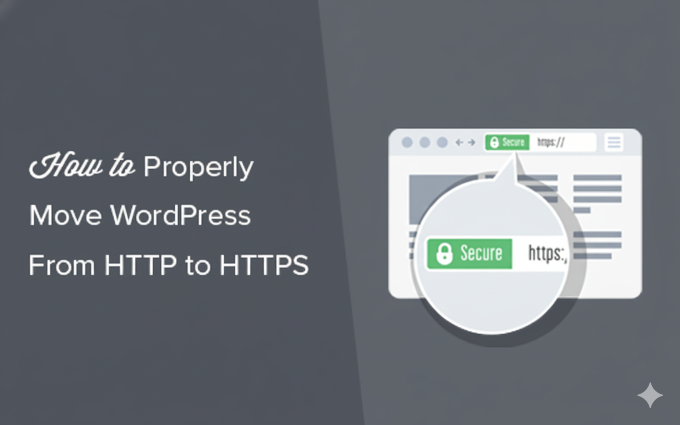
Resumen rápido: Cómo migrar WordPress a HTTPS en 4 pasos
- Obtén un certificado SSL.
- Instala y activa un plugin SSL como Really Simple SSL.
- Actualiza la configuración de tu sitio para usar HTTPS.
- Configura redirecciones y corrige cualquier error de contenido mixto.
Aquí tienes un resumen rápido de los temas que cubriremos en este artículo:
- ¿Qué es HTTPS?
- ¿Por qué necesita HTTPS y SSL?
- Requisitos para usar HTTPS/SSL en un sitio WordPress
- Configuración de WordPress para usar SSL y HTTPS
- Método 1: Configurar SSL/HTTPS en WordPress usando un plugin
- Method 2: Set Up SSL/HTTPS in WordPress Manually
- Submit Your HTTPS Site to Google Search Console
- Preguntas frecuentes sobre la migración a HTTPS
- Recursos adicionales para la seguridad de WordPress
¿Qué es HTTPS?
HTTPS (Protocolo Seguro de Transferencia de Hipertexto) es un método de encriptación que asegura la conexión entre el navegador de un usuario y el servidor de tu sitio web. Esta seguridad adicional hace mucho más difícil que los hackers intercepten los datos que se transfieren.
Para crear esta conexión segura, necesitas un certificado SSL (Capa de Conexión Segura). Si bien “SSL” es el término común que la gente usa, la tecnología moderna y más segura que usan los sitios hoy en día se llama TLS (Seguridad de la Capa de Transporte).
Cada sitio web recibe un certificado SSL único para su identificación. Si un servidor intenta usar HTTPS sin un certificado válido o si el certificado no coincide, la mayoría de los navegadores modernos alertarán a los usuarios y les aconsejarán que no continúen.
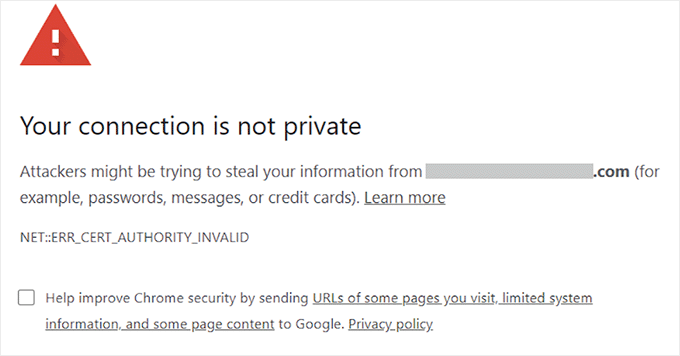
¿Por qué necesita HTTPS y SSL?
Allá por 2018, Google anunció una iniciativa para mejorar la seguridad web instando a los propietarios de sitios a cambiar de HTTP a HTTPS. Para apoyar este movimiento, su navegador Chrome comenzó a marcar todos los sitios web sin un certificado SSL como "No seguro".
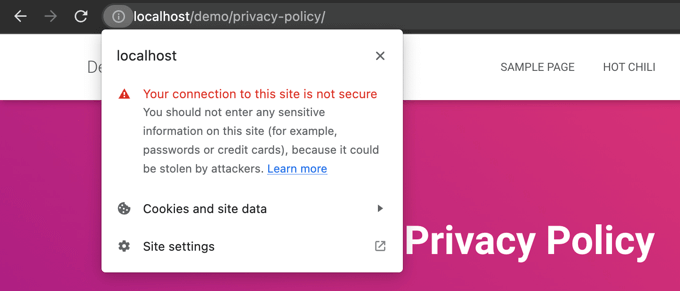
Esta advertencia de “No seguro” es especialmente prominente cuando alguien intenta ingresar información, como al completar un formulario de contacto. Ver esta advertencia puede dejar una impresión negativa y dañar la confianza en tu negocio.
Es por eso que todos los sitios web necesitan migrar a HTTPS e instalar SSL. Estos son los principales beneficios:
- Seguridad mejorada: Cifra los datos intercambiados entre tus visitantes y tu servidor, protegiendo información sensible como credenciales de inicio de sesión y detalles personales.
- Mejores rankings SEO: Google otorga una ligera ventaja en el ranking a los sitios web seguros con HTTPS.
- Genera confianza en el usuario: El ícono del candado seguro en la barra de direcciones del navegador señala instantáneamente a los visitantes que tu sitio es auténtico y seguro, lo que puede mejorar las tasas de conversión.
- Requerido para pagos en línea: Si deseas aceptar pagos en línea en tu sitio de comercio electrónico, los proveedores de pago como Stripe, PayPal Pro y Authorize.net requieren SSL.
Nos aseguramos de que todos nuestros propios sitios utilicen SSL, incluyendo WPBeginner y nuestras empresas asociadas.
Requisitos para usar HTTPS/SSL en un sitio WordPress
Los requisitos para usar SSL en WordPress no son muy altos. Todo lo que necesitas hacer es comprar un certificado SSL, y es posible que ya lo tengas gratis.
Las mejores empresas de hosting para WordPress ofrecen certificados SSL gratuitos para todos sus usuarios:
Para más detalles, consulta nuestra guía sobre cómo obtener un certificado SSL gratuito para tu sitio web de WordPress.
Si tu empresa de hosting no ofrece un certificado SSL gratuito, deberás comprar uno.
Recomendamos Namecheap porque ofrece la mejor oferta de SSL para certificados SSL regulares y comodín.
Una vez que hayas comprado un certificado SSL, deberás pedirle a tu proveedor de hosting que lo instale por ti.
Configuración de WordPress para usar SSL y HTTPS
Después de que tu host habilite un certificado SSL para tu nombre de dominio, deberás configurar WordPress para usar los protocolos SSL y HTTPS en tu sitio web.
Te mostraremos dos métodos para hacerlo, y puedes elegir el que mejor se adapte a tus necesidades.
Método 1: Configurar SSL/HTTPS en WordPress usando un plugin
Este método es más fácil y se recomienda para principiantes.
Primero, necesitas instalar y activar el plugin Really Simple SSL. Para más detalles, consulta nuestra guía paso a paso sobre cómo instalar un plugin de WordPress.
Al activarlo, deberás visitar la página de Seguridad. El plugin detectará automáticamente tu certificado SSL y te mostrará la opción ‘Activar SSL’.

Una vez activado, el plugin se encargará de todo, incluidos los errores de contenido mixto.
Esto es lo que hace el plugin en segundo plano:
- Verifica que haya un certificado SSL válido
- Configura WordPress para usar https en todas las URL
- Configura redirecciones de HTTP a HTTPS
- Busca URLs en tu contenido que todavía se cargan desde fuentes HTTP inseguras e intenta corregirlas.
Nota: El plugin intenta corregir los errores de contenido mixto utilizando una técnica de almacenamiento en búfer de salida. Esto puede tener un impacto negativo en el rendimiento porque reemplaza el contenido del sitio mientras se carga la página. Este impacto solo se observa en la primera carga de página y debería ser mínimo si estás utilizando un plugin de caché.
Si bien el plugin dice que puedes mantener SSL y desactivar el plugin de forma segura, no es 100% cierto. Tendrás que dejar el plugin activo en todo momento porque desactivarlo volverá a generar errores de contenido mixto. Consulta nuestra reseña de Really Simple SSL para más detalles.
Método 2: Configurar SSL/HTTPS en WordPress manualmente
Este método requiere que soluciones problemas manualmente y edite archivos de WordPress. Sin embargo, es una solución permanente y optimizada para el rendimiento, y es el método que usamos en WPBeginner.
Si te parece difícil este método, deberías contratar a un desarrollador de WordPress o usar el primer método en su lugar.
Como parte de este método, es posible que necesite editar archivos de temas y código. Si no lo ha hecho antes, consulte nuestra guía sobre copiar y pegar fragmentos de código en WordPress.
Primero, debe visitar la página Ajustes » Generales. Desde aquí, actualice los campos Dirección de WordPress y URL del sitio reemplazando http con https.
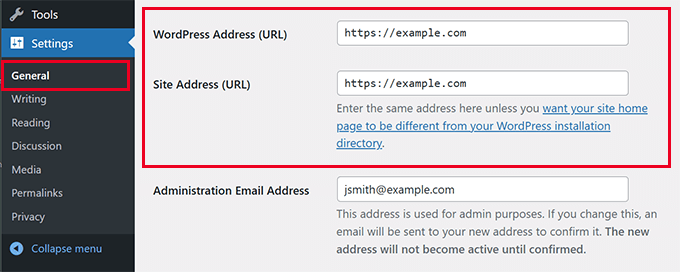
Luego, haga clic en el botón 'Guardar cambios' para almacenar la nueva configuración.
Una vez que se guarden los ajustes, WordPress te cerrará la sesión y se te pedirá que vuelvas a iniciarla.
A continuación, configure las redirecciones de WordPress de HTTP a HTTPS agregando el siguiente código al archivo .htaccess. Este código es para servidores Apache:
Si está en un servidor NGINX, agregará el siguiente código para redirigir de HTTP a HTTPS en el archivo de configuración:
No olvides reemplazar example.com con el nombre de tu dominio.
Siguiendo estos pasos, evitará el error de que HTTPS de WordPress no funciona porque WordPress ahora cargará todo el sitio web usando HTTPS.
Para forzar SSL y HTTPS en el área de administración de WordPress o en las páginas de inicio de sesión, necesita configurar SSL en el archivo wp-config.php.
Agregue el siguiente código encima de la línea "Eso es todo, deja de editar!" en el archivo wp-config.php:
define('FORCE_SSL_ADMIN', true);
Esta constante actúa como un mecanismo de seguridad. Asegura que tu página de inicio de sesión y el panel de administración de WordPress siempre estén encriptados, añadiendo una capa extra de seguridad para el administrador del sitio. También funciona en redes multisitio de WordPress.
Una vez hecho esto, el sitio web está completamente configurado para usar SSL / HTTPS, pero es posible que aún encuentres errores de contenido mixto.
Corrección de errores de contenido mixto
Los errores de contenido mixto son causados cuando parte del contenido (como imágenes, scripts o hojas de estilo) todavía se carga a través del protocolo HTTP inseguro en lugar de HTTPS.
Piensa en ello como tener una puerta principal segura y blindada (HTTPS) pero dejar una ventana abierta (un recurso HTTP). Esa única ventana abierta hace que toda la casa sea vulnerable.
Cuando esto sucede, no verás un ícono de candado seguro en la barra de direcciones de tu sitio web.

Puedes averiguar qué contenido se sirve a través de un protocolo inseguro utilizando la herramienta de inspección de tu navegador.
El error de contenido mixto se mostrará como una advertencia en la consola, con detalles para cada elemento.
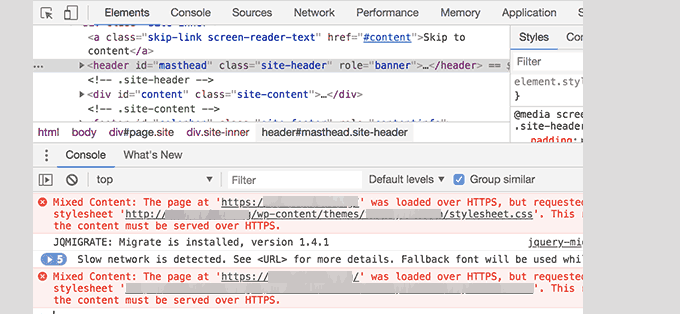
Notarás que la mayoría de las URL son imágenes, iframes y galerías de imágenes, mientras que algunas son scripts y hojas de estilo cargadas por plugins y temas de WordPress.
Solucionar contenido mixto en la base de datos de WordPress
La mayoría de las URL incorrectas serán para imágenes, archivos, incrustaciones y otros datos almacenados en la base de datos de WordPress. Vamos a arreglarlos primero.
Necesitas encontrar todas las menciones de la URL antigua de tu sitio web en la base de datos que comiencen con HTTP y reemplazarlas con la URL nueva de tu sitio web que comience con HTTPS.
Puedes hacer esto fácilmente instalando y activando el plugin Buscar y reemplazar todo.
Al activarse, visita la página Herramientas » WP Search & Replace. Necesitas agregar la URL de tu sitio web con http en el campo ‘Buscar’ y tu URL con https en el campo ‘Reemplazar’.
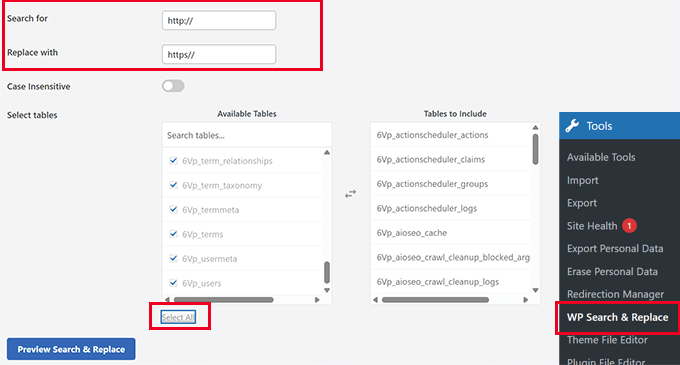
Luego, selecciona todas las tablas de la base de datos para realizar una verificación exhaustiva y haz clic en el botón ‘Reemplazar todo’. El plugin ahora actualizará todas las URL antiguas en la base de datos.
Corrección de errores de contenido mixto causados por el tema de WordPress
Cualquier tema de WordPress decente que siga los estándares de codificación de WordPress no causará este problema. Sin embargo, algunos aún pueden codificar URL inseguras.
Primero, necesitarás usar la herramienta Inspeccionar del navegador para encontrar los recursos y de dónde se están cargando. Después de eso, tendrás que encontrarlos en tu tema de WordPress y reemplazar http con https.
Esto será un poco difícil para la mayoría de los principiantes, ya que es posible que no puedas ver qué archivos del tema contienen estas URL.
Solución de errores de contenido mixto causados por plugins
Algunos recursos de contenido mixto serán cargados por plugins de WordPress. Cualquier plugin de WordPress que siga los estándares de codificación de WordPress no causará errores de contenido mixto.
No recomiendo editar los archivos de plugins de WordPress. En su lugar, te recomiendo contactar al autor del plugin y hacérselo saber. Si no responden o no pueden solucionarlo, entonces buscaría una alternativa adecuada.
Nota: Si, por alguna razón, sigues encontrando un error de contenido mixto, te recomendamos usar temporalmente el plugin Really Simple SSL para que tus usuarios no se vean afectados mientras solucionas el problema en un sitio web de staging o contratas a un desarrollador.
Envíe su sitio HTTPS a Google Search Console
Los motores de búsqueda como Google tratan https y http como dos sitios web diferentes. Para evitar cualquier problema de SEO, deberás informarle a Google que tu sitio web se ha mudado.
Para hacer eso, solo necesitas ir a tu cuenta de Google Search Console y hacer clic en el botón 'Agregar propiedad'.
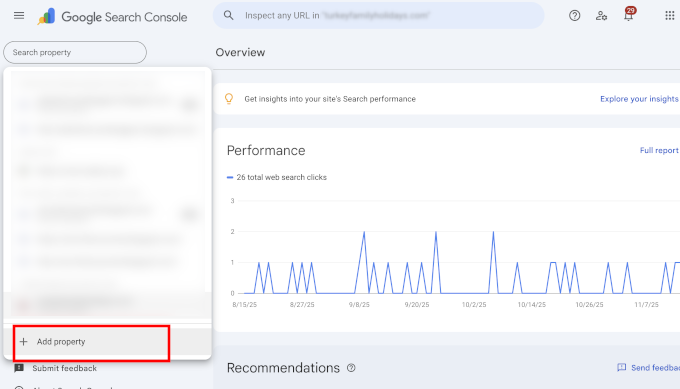
Esto abrirá una ventana emergente donde deberás agregar la nueva dirección HTTPS de tu sitio web.
Google ofrece varias formas de verificar tu sitio, pero recomendamos el método de prefijo de URL porque es más flexible.
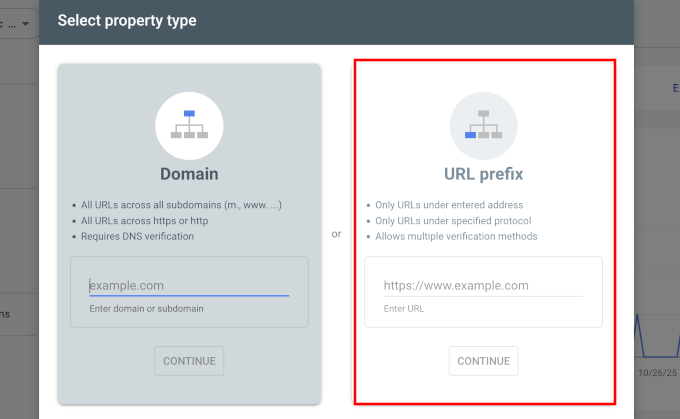
Después de eso, Google te pedirá que verifiques la propiedad de tu sitio web.
Hay varias formas de hacer esto, pero recomendamos usar el método de etiqueta HTML. Obtendrás un fragmento de código HTML para agregar a tu sitio de WordPress.
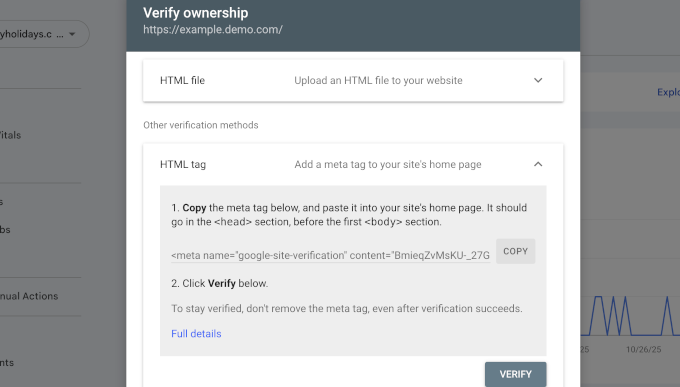
Agregar el código de verificación de la Consola de Búsqueda usando All in One SEO
Primero, instala y activa el plugin All in One SEO para WordPress. Para más detalles, consulta nuestro tutorial sobre cómo instalar un plugin de WordPress.
Consejo de experto: En WPBeginner, usamos All in One SEO en todos nuestros sitios web. La función de verificación de Herramientas para Webmasters nos ahorra mucho tiempo, ya que simplemente podemos pegar el código y AIOSEO lo agrega automáticamente al lugar correcto en el encabezado de nuestro sitio.
Después de la activación, ve a la página All in One SEO » Ajustes generales y haz clic en la pestaña Herramientas para Webmasters. Desde allí, haz clic en Google Search Console.
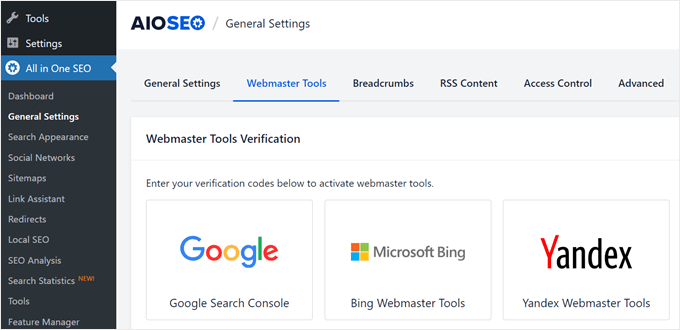
Aquí, debes agregar el código de verificación que copiaste anteriormente del sitio web de Google Search Console. No olvides hacer clic en el botón 'Guardar cambios' para almacenar tu configuración.
Luego, vuelve a la pestaña de Google Search Console y haz clic en el botón ‘Verificar’. Una vez que tu sitio esté verificado, Google comenzará a mostrar tus informes de Search Console.
También necesitas asegurarte de que tanto las versiones https como http se agreguen a tu Consola de Búsqueda.
Esto le indica a Google que deseas que la versión https de tu sitio web sea tratada como la versión principal. Combinado con las redirecciones 301 que configuraste anteriormente, Google transferirá tus rankings de búsqueda a la versión https de tu sitio web.
Preguntas frecuentes sobre la migración a HTTPS
¿Cuánto cuesta un certificado SSL?
Un certificado SSL puede ser gratuito. La mayoría de las principales empresas de hosting de WordPress ofrecen certificados SSL gratuitos a todos sus clientes a través de Let’s Encrypt. Si tu host no ofrece uno gratuito, puedes comprarlo a un proveedor como Namecheap por una tarifa anual baja.
¿Cuál es la diferencia entre SSL y HTTPS?
SSL (Secure Sockets Layer) es la tecnología que cifra los datos. HTTPS (Hypertext Transfer Protocol Secure) es el resultado de usar esa tecnología SSL. Cuando un sitio web tiene un certificado SSL válido, su URL comienza con https:// y aparece un ícono de candado en el navegador, lo que indica que la conexión es segura.
¿Qué sucede si no uso HTTPS?
Si no usas HTTPS, los navegadores modernos como Google Chrome mostrarán una advertencia de “No seguro” a tus visitantes. Esto puede erosionar la confianza, dañar la reputación de tu marca y hacer que pierdas clientes potenciales. Además, no tener HTTPS puede afectar negativamente tus rankings en los motores de búsqueda.
Recursos adicionales para la seguridad de WordPress
Los siguientes son algunos recursos adicionales que pueden ayudarte a solucionar problemas comunes de WordPress y aprender más sobre la seguridad del sitio web:
- Cómo solucionar problemas comunes de SSL en WordPress (Guía para principiantes)
- Los errores más comunes de WordPress y cómo solucionarlos
- Cómo solucionar el error de conexión segura en WordPress
Esperamos que este artículo te haya ayudado a agregar HTTPS y SSL en WordPress. También te puede interesar nuestro guía definitiva de seguridad de WordPress con instrucciones paso a paso para mantener tu sitio de WordPress seguro o nuestra guía sobre cómo renovar tu certificado SSL.
Si te gustó este artículo, suscríbete a nuestro canal de YouTube para obtener tutoriales en video de WordPress. También puedes encontrarnos en Twitter y Facebook.





Yasir
¿Es seguro este plugin?
Soporte de WPBeginner
Sí, el plugin debería ser seguro actualmente.
Administrador
ammar
Hola, si estoy usando el primer método, ¿necesito seguir también el paso de Enviar mi sitio HTTPS a la Consola de Búsqueda de Google después de eso?
TQ
Soporte de WPBeginner
Sí, aún querrás seguir ese paso
Administrador
Swen
Instalé el plugin Really Simple SSL, que indica que debes reemplazar manualmente cada http:// en todos los archivos .css y .js por //. Eso no me parece realmente simple. Como principiante, configuré un sitio web simple con un par de imágenes. ¿Es común que haya declaraciones http:// en estos archivos?
Soporte de WPBeginner
Normalmente esos enlaces no son comunes, así que no debería ser algo de qué preocuparse.
Administrador
Lucas
Hola,
Al agregar el código a .htaccess, obtengo un error de "demasiadas redirecciones". Intenté agregarlo al código existente arriba, abajo, y también borrando el código existente y usando solo el nuevo. Las tres opciones generan demasiadas redirecciones.
¿Hay algo que deba cambiar ahí? ¡Gracias de antemano por tu ayuda!
Soporte de WPBeginner
Querrías probar algunas de las sugerencias en nuestro artículo aquí:
https://www.wpbeginner.com/wp-tutorials/how-to-fix-error-too-many-redirects-issue-in-wordpress/
para resolver el problema de demasiadas redirecciones y si esas recomendaciones no funcionan, deberías consultar con tu proveedor de hosting para asegurarte de que no tengan un sistema que necesite ser modificado para apuntar a la versión https de tu sitio.
Administrador
Sotir Sotirov
He intentado usar el plugin, pero cuando lo hago, el sitio web deja de ser accesible. He intentado el enfoque manual, pero una vez que he cambiado las direcciones en la configuración de WP, el sitio vuelve a dejar de ser accesible.
Soporte de WPBeginner
You would want to reach out to your hosting provider to ensure that your SSL certificate is connected to your domain correctly and they should be able to help
Administrador
Mike Ashworth
Estoy a punto de hacer el cambio a SSL y seguiré la guía del artículo, inicialmente usando el plugin Really Simple SSL. Antes de empezar, tengo una pregunta rápida.
Si uso el plugin Really Simple SSL, que se encarga de todo, ¿puedo dejar la configuración general en WordPress para la dirección de WordPress y la dirección del sitio como http en lugar de cambiar a https, ya que el plugin se encargará de ello?
Soporte de WPBeginner
Correct
Administrador
Mike Ashworth
Gracias por confirmar. Tengo otra pregunta.
Acabo de activar el SSL de Let's Encrypt en SiteGround para un sitio web, y me preguntan si quiero activar lo siguiente o dejarlo desactivado.
Forzar HTTPS – Obliga a que tu sitio funcione completamente a través de una conexión HTTPS cifrada. La redirección se realiza a nivel de servidor y funciona para cualquier sitio web.
¿Debo dejar esto desactivado ya que el plugin Really Simple SSL también se encargará de esto?
Soporte de WPBeginner
Sí, puedes dejarlo desactivado, solo deberías usarlo si hay algún problema con el plugin o si Google encuentra enlaces http.
Mike Ashworth
Gracias por tu consejo. WP Beginner es un sitio web increíble. ¡Sigan con el gran trabajo!
stephan
Te agradezco mucho. Estuve buscando los errores durante más de 12 horas y lo solucioné con plugins de reemplazo mejorados. Muchas gracias, querido.
Soporte de WPBeginner
Glad our recommendation could help you
Administrador
Arlina
¿Añadir el plugin SSL ralentiza el rendimiento de mi blog?
Soporte de WPBeginner
No debería ralentizar tu sitio.
Administrador
Peter Wilson
¿Alguien puede decirme si reemplazo el contenido de mi archivo .htaccess con el código sugerido o si lo coloco al principio/final de la entrada existente?
Soporte de WPBeginner
Lo añadirías al final del código actual en tu archivo .htaccess.
Administrador
Peter Wilson
Gracias por la rápida respuesta. Entonces, ¿sería después de lo existente y antes de # END WordPress, o va después del .
Soporte de WPBeginner
That should not matter, it may be a good idea to do it after should you need to remove the code in the future
Shivanandana
¡Guía realmente genial. ¡Muchas gracias! ¡Gracias de nuevo por esta publicación detallada!
Soporte de WPBeginner
Glad you like our content
Administrador
Håkan
¡Gran contenido, me ayudó mucho!
Soporte de WPBeginner
Thank you, glad our content was helpful
Administrador
Harsha
¡Guía muy útil, muchas gracias!
Soporte de WPBeginner
You’re welcome, glad our article was helpful
Administrador
Jan-Peter Molenaar
Thanks a lot!! Valuable content
Soporte de WPBeginner
You’re welcome, glad our content is helpful
Administrador
Greg
Este artículo fue de gran ayuda. ¡Muchas gracias! Lo hizo muy fácil.
Soporte de WPBeginner
You’re welcome, glad our article was helpful
Administrador
Nel
La guía más útil que he visto. Gracias por esto.
Soporte de WPBeginner
You’re welcome
Administrador
Jessica Quadra
Esto fue de gran ayuda y cada paso funcionó perfectamente. ¡¡Gracias!!
Soporte de WPBeginner
You’re welcome, glad our guide could help
Administrador
Hassen Loukil
¡Hola!
¡Gracias por el artículo!
¿Qué pasa con Google Analytics? ¿Es lo mismo que Google Search Console o no?
Soporte de WPBeginner
Para Google Analytics deberías poder actualizar a https en la configuración de tu propiedad
Administrador
Arif Ahmed
Cuando habilito la opción "Redirección de WordPress 301 a SSL" del "Plugin Really Simple SSL" funciona bien, pero elimina los parámetros de consulta. Por ejemplo, cuando recibo usuarios de una campaña de Adwords, elimina los parámetros gclid.
Por favor, guíame
Soporte de WPBeginner
Deberías contactar al soporte de Really Simple SSL para ver si hay una opción para cadenas de consulta.
Administrador
Oswald Porter
Gracias por tu útil artículo.
La configuración manual de SSL/HTTPS parece estar funcionando para el sitio principal.
Sin embargo, el error de contenido mixto (imágenes) todavía aparece después de usar el plugin Better Search Replace.
En la Biblioteca de Medios, las imágenes aparecen con 'https', pero no en cada publicación del sitio.
De hecho, en todas las publicaciones, cuando hago clic derecho en la imagen de la publicación y selecciono 'Copiar dirección de la imagen', muestra:
http://
¿Ideas? Gracias de antemano.
Soporte de WPBeginner
Deberías empezar por borrar cualquier caché de tu sitio y si eso no funciona, podrías probar el plugin Velvet Blues de nuestro artículo: https://www.wpbeginner.com/plugins/how-to-update-urls-when-moving-your-wordpress-site/
Administrador
Kathy
Hola,
He usado este tutorial en muchos sitios y funciona de maravilla. Gracias por eso.
¿Sabes si también puedo usarlo para actualizar mis multisitios? ¿O se necesitan pasos adicionales?
Soporte de WPBeginner
Dependiendo de cómo esté configurado tu multisitio, normalmente hay más pasos involucrados. Si te pones en contacto con tu proveedor de hosting, normalmente pueden ayudarte
Administrador
Ralph
Gracias, muy buen tutorial.
Soporte de WPBeginner
Thanks, glad you liked our guide
Administrador
Oz
¡Fantástico y directo!
¿Qué pasos debemos seguir para asegurarnos de que nuestro recuento de compartidos en redes sociales (por ejemplo, Facebook, Twitter) siga disponible?
Soporte de WPBeginner
Podrías intentar redirigir 301 los artículos http a https, pero a menos que me digan lo contrario, los sitios de redes sociales ven los dos como enlaces diferentes, por lo que es probable que pierdas tus compartidos a menos que hayan agregado un método para actualizar tus recuentos de compartidos.
Administrador
Ahsan
Usé Cloudflare para SSL gratis, pero mi tráfico ha bajado un 25%. ¿Se debe a Cloudflare?
Soporte de WPBeginner
Hay múltiples razones posibles para un cambio en el tráfico, por lo que es difícil decir si esa es la única razón o si hubo otras razones para una caída en el tráfico.
Administrador
Shawn
Gracias por una pieza de contenido tan genial.
Parece que usar el plugin Really Simple SSL es mucho más fácil que cambiar códigos y scripts por mi cuenta.
Mi pregunta: ¿qué pasa si el plugin no se actualiza en el futuro? ¿Esto causará un problema para nuestras URLs?
Y, después de instalar el SSL de mi proveedor de hosting web, ¿todo lo que necesito hacer es activar el plugin Really Simple SSL y todo se redirigirá a https?
Shawn
Soporte de WPBeginner
Dependería de los cambios en el código principal de WordPress y de cuánto tiempo no se haya actualizado para los posibles problemas. El plugin debería actualizar automáticamente tu contenido para que pueda usar HTTPS sin que necesites modificar nada de tu parte si quisieras.
Administrador
Nathaniel
Solo quería decir gracias. No tenía ganas de hacer esto, pero tu guía lo hizo fácil y rápido. ¡¡¡Gracias!!!
Soporte de WPBeginner
Glad our guide could help
Administrador
Sheri Ellis
Cometí el error de seguir tus instrucciones manuales antes de que se instalara nuestro certificado SSL. Lo único que hice fue editar la configuración general de la URL a https. Y ahora el sitio está arruinado. He estado editando cada archivo PHP para incluir:
define( ‘WP_HOME’, ‘http://mysite.com’ );
define( ‘WP_SITEURL’, ‘http://mysite.com’ );
y está siendo ignorado. Así que ahora mi sitio está arruinado. Para tu información, estoy usando WordPress 5.1.1, que parece tener cambios significativos. ¡Ayuda!
Soporte de WPBeginner
Deberías poder editar la URL de regreso usando phpMyAdmin de manera similar a nuestro artículo aquí: https://www.wpbeginner.com/beginners-guide/how-to-reset-a-wordpress-password-from-phpmyadmin/
y editar la tabla de opciones en lugar de la tabla de usuarios.
Administrador
Sheri Ellis
Gracias por la respuesta, pero no funcionó. Ejecuté el comando de línea de mysql para actualizar la tabla wp_options y establecí option_value a http donde option_name está en ('home','siteurl'). También he insertado los comandos define HOME y SITEURL en muchos archivos PHP, incluido wp-config.php, y también agregué define( ‘RELOCATE’, true );
Sigue arruinado. ¡Agradezco cualquier sugerencia adicional!
Soporte de WPBeginner
You may want to ensure if you have a caching plugin that you disable it, as you are unable to log into the site you could use: https://www.wpbeginner.com/plugins/how-to-deactivate-all-plugins-when-not-able-to-access-wp-admin/
otherwise, if you reach out to your hosting provider they should be able to assist
Sheri Ellis
Ya lo había intentado también, sin éxito. Tuve que eliminar todo el sitio y reinstalar WP. ¡Pero aprecio el esfuerzo!
John J Cooke
Esto hizo que hacer el cambio fuera pan comido. Tenía el certificado SSL sin una forma segura de convertirlo. Realmente aprecio las instrucciones sencillas.
Soporte de WPBeginner
Glad we could make the process easier for you
Administrador
Mandee
¡Oh Dios mío, GRACIAS! Me puse en contacto con mi empresa de hosting, así como con un desarrollador. Ambos hicieron que pareciera una tarea imposible de hacer por mi cuenta. Acabo de resolver esto en literalmente 30 segundos gracias a ti. ¡No puedo agradecerte lo suficiente! Ojalá hubiera encontrado este artículo antes, ¡me habría ahorrado muchos dolores de cabeza!
Soporte de WPBeginner
Glad our article could help
Administrador
Jerry
Hola,
Intenté tu guía paso a paso dos veces y todo funcionó muy bien. Ahora que tengo SSL, estoy intentando migrar, pero hay un problema en el último paso, por lo que no se puede finalizar. ¿Es un problema que tuviera Let's Encrypt en el servidor antiguo y ahora que el nuevo tiene otro, haya causado un problema? ¿Recomendarías eliminar SSL en el hosting antiguo y después usar duplicator para iniciar el proceso de artículos?
Soporte de WPBeginner
Quién tenga tu SSL no debería ser un factor para que no funcione, podrías intentar ver si eso funciona, pero normalmente se debe a otra causa.
Administrador
BILAL ALI AHMAD
Hola,
Apliqué todos los pasos y la versión https funciona bien en mi sitio web, pero la versión no https sigue siendo accesible cuando escribo http: mysite.com
¿cómo resolver este problema?
Además, cuando hago clic en mi enlace de búsqueda de Google para mi sitio web, el usuario también aterriza en la versión no https y después de eso, si accedo al sitio web nuevamente, viene con https.
¿por favor, dime cómo resolver este problema?
Soporte de WPBeginner
Si ya enviaste tu sitio a la consola de búsqueda de Google, es posible que Google haya almacenado en caché la versión http en su búsqueda. Para que la versión http esté disponible, es posible que desees asegurarte de que todas las redirecciones se guardaron.
Administrador
Clement
Esto fue sorprendentemente simple, por eso confío en ustedes, en realidad pensé que sería horrible.
Soporte de WPBeginner
Glad our guide could make it easy for you
Administrador
Marc-Lyon
Gracias por el gran tutorial. El único problema con el que estoy atascado es que las URL con www agregado muestran un mensaje de error en el navegador:
“Este sitio no puede proporcionar una conexión segura porque usa un protocolo no admitido.
ERR_SSL_VERSION_OR_CIPHER_MISMATCH
Protocolo no admitido
El cliente y el servidor no admiten una versión de protocolo SSL o un conjunto de cifrado común.”
He comprobado y tanto la versión sin www como la versión con www tienen certificados SSL válidos. ¿Alguna idea de por qué la versión con www no funciona?
Soporte de WPBeginner
Empieza por ponerte en contacto con tu proveedor de hosting para asegurarte de que no tienen una configuración de su lado para la versión específica con www de tu sitio.
Administrador
Marc-Lyon
Logramos resolverlo. Cloudflare estaba causando el problema.
Solución: deshabilitar y volver a habilitar Universal SSL en la configuración de Crypto.
Soporte de WPBeginner
Glad you were able to find the cause and thanks for sharing the solution should anyone else run into the issue
Genial
Muy útil este blog. Gracias.
Soporte de WPBeginner
You’re welcome
Administrador
illy
Todas mis imágenes se insertaron con el protocolo http. Usé Better Search Replace para arreglar esto y ¡funcionó de maravilla!
gracias
Soporte de WPBeginner
Glad our recommendation could help
Administrador
Didier
Tengo un problema con la redirección de http a https.
Usando el código mencionado anteriormente en el archivo .htaccess,
mi página de índice http://example.com redirige a https://example.com
PERO
Una subpágina http://example.com/sublink NO redirige a https://example.com/sublink
¿Alguien sabe cómo resolver esto?
¡Gracias!
Soporte de WPBeginner
Es posible que desees contactar a tu proveedor de hosting para asegurarte de que no estén anulando ninguna redirección en tu sitio o si ven que el código se copió incorrectamente.
Administrador
Jason
¡Siiiiiiiiiiiiiiiiiiiiiiiiiiiiiiiiiiiiiiiiiiii! ¡La primera edición de WP que me ha funcionado a la primera! Me tomaré el resto del día libre para celebrarlo.
Soporte de WPBeginner
Glad our guide could help
Administrador
Leo Al
¡Muchas gracias!
It worked
Soporte de WPBeginner
Glad our article could help
Administrador
Igor N
Gracias, eso fue realmente útil. Elegí el método 2 y todo salió bien.
Soporte de WPBeginner
Glad our tutorial could help and you got it working
Administrador
Pamela
¡Este detallado artículo salvó a un principiante como yo! Muy útil. Muchas gracias.
Soporte de WPBeginner
Glad our guide could be helpful
Administrador
Rafaqat Ali
Hola, gracias por el artículo. He cambiado mi sitio a SSL usando el artículo elaborado anteriormente.
Permítanme aclarar algunas cosas:
1- He agregado una nueva propiedad en Google Search Console con https://. ¿Debo eliminar la propiedad http:// o mantener ambas?
2- ¿Cuánto tiempo tardará en mostrarse los datos de búsqueda de Google en el informe de la Search Console?
3- ¿Debo hacer una redirección 301 a la versión https://?
4- ¿Cómo consigo que todos mis backlinks apunten a la versión https://?
(Ya envié el sitemap XML y el archivo robots.txt también con la nueva propiedad)
Gracias por su tiempo
Soporte de WPBeginner
Hey Rafaqat,
Si ha configurado una redirección 301 a sus URL HTTPS, entonces puede dejarlas ambas. Comenzarán a aparecer en las búsquedas muy pronto; sin embargo, si sus redirecciones están configuradas correctamente, no verá ninguna diferencia en su tráfico o en sus rankings de búsqueda.
Administrador
Belinda
Thankyou so so much, this article helped me fix both my blog and online store.
Roberto
¡Es un artículo increíble, resolví mi problema y ahora tengo mi sitio en funcionamiento. ¡Muchas gracias!
Personal editorial
De nada, Roberto
Administrador
Eva
Hola y gracias por el tutorial detallado
Activé el protocolo SSL en una nueva instalación de WordPress y después de la activación, el sitio comenzó a abrirse con https y el candado verde (todas las páginas, con y sin www, buscando y si se busca la versión http), incluso el área de administración, hasta el tema y el editor. Sin embargo, los campos de URL de WordPress y del sitio en la página de Configuración General aún necesitan ser cambiados a https, ya que aparecen como http y cualquier publicación nueva (así como las que ya estaban allí) tiene un enlace http y cuando edito la apariencia de la página desde el menú principal, muestra un signo de exclamación sobre el candado de conexión segura.
En ese caso, ¿necesito pasar por todo el proceso o después de actualizar la página de configuración general a https, estará bien?
Es mi primera vez haciendo esto y prefiero (si tengo que hacerlo) hacerlo manualmente por el método 2, ya que está muy bien explicado.
Gracias
Soporte de WPBeginner
Hola Eva,
Puedes intentar el segundo método o seguir las instrucciones del primer método. Necesitarás cambiar las URL en la configuración, ya que le indica a WordPress que use https en las URL.
Administrador
Bernard Brillo
He intentado seguir el tutorial manual, pero termino viendo una página en blanco en mi página de inicio y todas mis otras páginas ahora son inaccesibles. Mi sitio web está alojado en Amazon y también estoy usando W3 total cache.
¿Necesito hacer algo más para que esto funcione?
Cualquier sugerencia será muy apreciada.
Donatas Vaiciulis
En mi sitio web estaba W3 total cache, cuando lo deshabilité funcionó todo bien. Creo que después de editar htaccess, necesitaba reinstalar el plugin y volver a configurar w3. Aún no lo he probado, pronto lo intentaré.
Josh
Hice el método 1 y funcionó perfectamente. ¡Muchas gracias por el tutorial!
Karo Itoje
Hola,
Como siempre, gracias por el tutorial detallado. Decidí hacer la opción manual (opción 2) porque parecía lo suficientemente simple de seguir. Sin embargo, cuando pegué el segundo código para servidores nginx en el archivo de configuración (wp-config.php), obtuve un error de sintaxis. Así que tuve que eliminar el código. Pero aún así me gustaría seguir con esa opción, así que si puedes echarle un vistazo a ese código de nuevo y corregirlo, te lo agradecería mucho.
Además, solo para que quede claro, es una de estas opciones:
"configurar las redirecciones de WordPress de HTTP a HTTPS agregando el siguiente código a tu archivo .htaccess."
O ESTO
"Si estás en servidores nginx (la mayoría de los usuarios no lo están), entonces necesitarías agregar el siguiente código para redirigir de HTTP a HTTPS en tu archivo de configuración:"
¿No ambas, verdad?
mostafa elaissaoui
gracias
Realmente me ayudas, gracias
Rohan Kothari
Hola,
Estoy planeando abrir una tienda de comercio electrónico. ¿Necesito comprar un certificado SSL comodín y una IP dedicada para habilitar pagos en mi sitio web o será suficiente el certificado SSL gratuito incluido en los planes de alojamiento web?
Oliver
Hola a todos,
Primero que nada, un artículo genial y útil, gracias. He cambiado mi sitio de http a https y me tomó mucho menos tiempo de lo que esperaba, usando el método manual de Better Search and Replace. Pero ahora no puedo cambiar la dirección de la versión http en Google Search Console. Tiene ambos sitios allí pero no me permite cambiarlos. ¿Es necesario hacerlo? Parece que las redirecciones están funcionando. ¿Debería hacer que el sitio https se indexe lo más posible o Google lo hará de todos modos con las redirecciones http?
Soporte de WPBeginner
Hola Oliver,
Si tienes ambos sitios en la consola de búsqueda y una redirección implementada, entonces Google detectará automáticamente la transición y comenzará a mostrar informes para tu sitio HTTPS.
Administrador
Victor Fernando
Usé el primer método, aunque tengo experiencia en programación, no la tengo en wordpress y no me atrevo a meterme con el código aunque no sea tan complicado.
el primer método funcionó, es decir, instalando la versión gratuita del plugin.
Gracias por el consejo